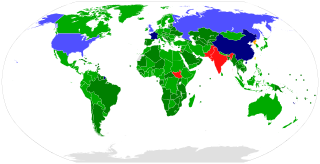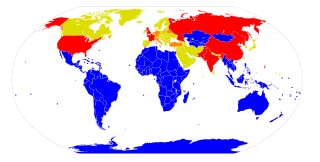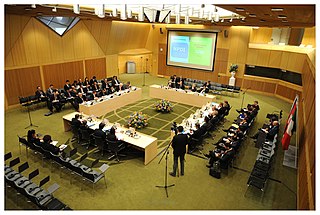Members

The New Agenda Coalition (NAC), composed of Brazil, Egypt, Ireland, Mexico, New Zealand and South Africa, is a geographically dispersed group of middle power countries seeking to build an international consensus to make progress on nuclear disarmament, as legally called for in the nuclear NPT.
The group was formed in response to the North-South divide that stymied talks on nuclear disarmament and non-proliferation within the framework of the NPT. Non-nuclear weapon states believed not enough progress was being made on disarmament to have warranted the indefinite extension of the treaty in 1995, and that nuclear weapons states were not fulfilling their legal responsibilities towards disarmament, as outlined by Article VI of the NPT.
The NAC was officially launched in Dublin in June 1998, with a Joint Declaration [1] by the Ministers for Foreign Affairs of Brazil, Egypt, Ireland, Mexico, New Zealand, South Africa, Sweden, and Slovenia, the latter two of which subsequently left the Coalition. [2]
On June 9, 1998, an 18-point declaration entitled "A Nuclear-Weapons-Free World: The Need for a New Agenda" was signed by the governments of the eight nations of Brazil, Egypt, Ireland, Mexico, New Zealand, Slovenia, South Africa, and Sweden [3] [4] [5] to shape foreign policy around the goal of "the elimination of nuclear weapons and assurance that they will never be produced again." [6] [7] Of particular concern to the signatories are the states who have refused to sign the Nuclear Non-Proliferation Treaty. The Nuclear Free World Policy is considered by many to be a "fundamental and requisite step" following from the treaty. New Zealand's stand on nuclear issues was a step on the way towards the Nuclear Free World Policy.
The declaration begins:
"1. We, the Ministers for Foreign Affairs of Brazil, Egypt, Ireland, Mexico, New Zealand, Slovenia, South Africa and Sweden have considered the continued threat to humanity represented by the perspective of the indefinite possession of nuclear weapons by the nuclear-weapon states as well as by those three nuclear-weapons-capable states that have not acceded to the Non-Proliferation Treaty, and the attendant possibility of use or threat of use of nuclear weapons. The seriousness of this predicament has been further underscored by the recent nuclear tests conducted by India and Pakistan." [8]

In 2000, the New Agenda Coalition was instrumental in crafting a breakthrough in the NPT Review Conference. While prospects at the outset of the conference initially seemed bleak, the New Agenda Coalition put together a historic agreement outlined in the 13 Steps, in which the nuclear weapons states affirmed, in accordance with Article VI of the NPT, that nuclear disarmament can and should proceed independently of general disarmament, that the nuclear powers have a responsibility to work together on "an unequivocal undertaking" to eliminate their arsenals, and that 13 relatively simple steps could help rid the world of nuclear weapons quickly, verifiably, and irreversibly.
Since the 2000 Review conference, the New Agenda Coalition has submitted annual resolutions to the UN First Committee on Disarmament and International Security. Each of the Coalition's resolutions has been approved by the committee with overwhelming support. They also continue to advance position papers at the NPT review meetings and their preparatory meetings.
All current members of the New Agenda Coalition have joined the Humanitarian Initiative, [9] which was founded in 2013 also in the context of the NPT.

The Treaty on the Non-Proliferation of Nuclear Weapons, commonly known as the Non-Proliferation Treaty or NPT, is an international treaty whose objective is to prevent the spread of nuclear weapons and weapons technology, to promote cooperation in the peaceful uses of nuclear energy, and to further the goal of achieving nuclear disarmament and general and complete disarmament. Between 1965 and 1968, the treaty was negotiated by the Eighteen Nation Committee on Disarmament, a United Nations-sponsored organization based in Geneva, Switzerland.

Nuclear proliferation is the spread of nuclear weapons, fissionable material, and weapons-applicable nuclear technology and information to nations not recognized as "Nuclear Weapon States" by the Treaty on the Non-Proliferation of Nuclear Weapons, commonly known as the Non-Proliferation Treaty or NPT. Proliferation has been opposed by many nations with and without nuclear weapons, as governments fear that more countries with nuclear weapons will increase the possibility of nuclear warfare, de-stabilize international or regional relations, or infringe upon the national sovereignty of nation states.

Nuclear disarmament is the act of reducing or eliminating nuclear weapons. Its end state can also be a nuclear-weapons-free world, in which nuclear weapons are completely eliminated. The term denuclearization is also used to describe the process leading to complete nuclear disarmament.

The Nuclear Suppliers Group (NSG) is a multilateral export control regime and a group of nuclear supplier countries that seek to prevent nuclear proliferation by controlling the export of materials, equipment and technology that can be used to manufacture nuclear weapons.

Taiwan pursued a number of weapons of mass destruction programs from 1949 to the late 1980s. The final secret nuclear weapons program was shut down in the late 1980s under US pressure after completing all stages of weapons development besides final assembly and testing; they lacked an effective delivery mechanism and would have needed to further miniaturize any weapon before it could be effectively used in combat. Currently, there is no evidence of Taiwan possessing any chemical, biological, or nuclear weapons. However, nuclear weapons from the United States were deployed to Taiwan during a period of heightened regional tensions with China beginning with the First Taiwan Strait Crisis and ending in the 1970s.

A nuclear-weapon-free zone (NWFZ) is defined by the United Nations as an agreement that a group of states has freely established by treaty or convention that bans the development, manufacturing, control, possession, testing, stationing or transporting of nuclear weapons in a given area, that has mechanisms of verification and control to enforce its obligations, and that is recognized as such by the General Assembly of the United Nations. NWFZs have a similar purpose to, but are distinct from, the Treaty on the Non-Proliferation of Nuclear Weapons to which most countries including five nuclear weapons states are a party. Another term, nuclear-free zone, often means an area that has banned both nuclear power and nuclear weapons, and sometimes nuclear waste and nuclear propulsion, and usually does not mean a UN-acknowledged international treaty.

United Nations Security Council resolution 1540 was adopted unanimously on 28 April 2004 regarding the non-proliferation of weapons of mass destruction. The resolution establishes the obligations under Chapter VII of the United Nations Charter for all member states to develop and enforce appropriate legal and regulatory measures against the proliferation of chemical, biological, radiological, and nuclear weapons and their means of delivery, in particular, to prevent the spread of weapons of mass destruction to non-state actors.
The Nuclear Free World Policy is a commitment by a bloc of countries known as the New Agenda Coalition (NAC) to shape foreign policy around the goal of "the elimination of nuclear weapons and assurance that they will never be produced again." The policy arose from an 18-point Joint Declaration signed by the Ministers of foreign affairs of Brazil, Egypt, Ireland, Mexico, New Zealand, South Africa, Slovenia and Sweden on June 9, 1998. The signatories of this Joint Declaration became member-states of the NAC, although Slovenia and Sweden subsequently left the Coalition.
The 13 steps are identified in a paragraph of the Final Document of the 2000 Review Conference of the Nuclear Non-Proliferation Treaty, providing a set of 'practical steps for the systematic and progressive efforts to implement Article VI of the Treaty on the Non-Proliferation of Nuclear Weapons'. Article VI is the part of the Treaty that provides for disarmament, including nuclear disarmament.
The International Luxembourg Forum on Preventing Nuclear Catastrophe — is an international non-governmental organisation uniting leading world-renowned experts on non-proliferation of nuclear weapons, materials and delivery vehicles.

United Nations Security Council Resolution 1887, adopted unanimously on 24 September 2009, the Council addressed non-proliferation and the prevention of the spread of weapons of mass destruction in the world.

In United Nations Security Council resolution 984, adopted unanimously on 11 April 1995, the council gave assurances to non-nuclear weapon states that were parties to the Nuclear Non-Proliferation Treaty (NPT) against the threat of nuclear proliferation.
The 2010 Review Conference for the Treaty on the Non-Proliferation of Nuclear Weapons (NPT) was held at United Nations Headquarters in New York City from 3 to 28 May 2010. The President of the Review Conference is Ambassador Libran N. Cabactulan of the Philippines. UN Secretary-General Ban Ki-moon used the opening of the conference to note that "sixty five years later, the world still lives under the nuclear shadow".
A security assurance, in the context of nuclear warfare, is an expression of a political position by a nuclear-armed nation intended to placate other non-nuclear-armed nations. There are two types of security assurance: positive and negative. A positive assurance states that the nation giving it will aid any or a particular non-nuclear-armed nation in retaliation if it is a victim of nuclear attack. A negative assurance is not the opposite but instead means that a nuclear-armed nation has promised not to use nuclear weapons except in retaliation for a nuclear attack against itself.

The Middle East nuclear weapon free zone (MENWFZ) is a proposed agreement similar to other nuclear-weapon-free zones. Steps towards the establishment of such a zone began in the 1960s led to a joint declaration by Egypt and Iran in 1974 which resulted in a General Assembly resolution. Following the 1995 NPT Review Conference, the International Atomic Energy Agency (IAEA) held a series of meetings involving experts and academics to consider ways to advance this process.

The Non-Proliferation and Disarmament Initiative (NPDI) is a coalition of states within the framework of the Nuclear Non-Proliferation Treaty (NPT) formed in 2010.
The Humanitarian Initiative is a group of states that evolved within the framework of the Nuclear Non-Proliferation Treaty (NPT) and nuclear weapons diplomacy more widely. 159 states subscribed to the last iteration of the initiative's Joint Statement in 2015. Since 2013, it led to a series of conferences exploring the Humanitarian Impact of Nuclear Weapons, culminating in the Humanitarian Pledge, issued by the Austrian Government, to "fill the legal gap for the prohibition and elimination of nuclear weapons". The Pledge has been endorsed by 108 governments as of 1 June 2015. The Humanitarian Initiative is seen as a direct answer to the lack of progress in nuclear disarmament.

The Treaty on the Prohibition of Nuclear Weapons (TPNW), or the Nuclear Weapon Ban Treaty, is the first legally binding international agreement to comprehensively prohibit nuclear weapons with the ultimate goal being their total elimination. It was adopted on 7 July 2017, opened for signature on 20 September 2017, and entered into force on 22 January 2021.